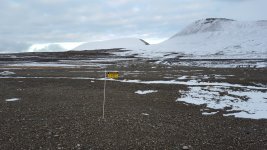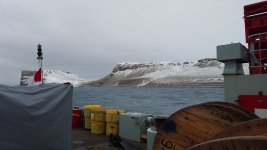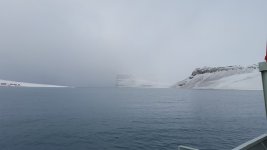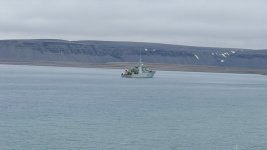View attachment 78518
Not as many as you think. Two ways in on the west side, one way in on the east side. The other channels are NOT recommended for even icebreakers (particularly south of Baffin Island) as the ice can pile up even in summer.
Between a few subs, few AOPS, and some air assets not to many ways to sneak in. It's just so far north.
There is a new way of doing procurement coming as well. Its called something like Capability Sustainment Procurement. Just go shopping find what works and buy it. Sub program might be to big for that though.
Time for a historical intervention.
At the time Montreal was invading New York and Selkirk's indigent Scots were invading the Red River valley by way of Hudson's Bay, the waters through which those HBC boats passed to get into the Bay were claimed by both the Brits and the Denmark-Norway Kingdom. That Kingdom existed until 1814 and the Battle of New Orleans. One thing had nothing to do with the other.
That Kingdom included:
the Kingdom of
Denmark, the Kingdom of
Norway (including the then Norwegian overseas possessions: the
Faroe Islands,
Iceland,
Greenland, and
other possessions), the
Duchy of Schleswig, and the
Duchy of Holstein. The state also claimed sovereignty over three historical peoples:
Frisians,
Gutes and
Wends. Denmark–Norway had several colonies, namely the
Danish Gold Coast, the
Nicobar Islands,
Serampore,
Tharangambadi, and the
Danish West Indies.
Norway's "other possessions" included, and include, Svalbard and Jan Mayen. But the claim also included Axel Heiberg, Ellef Ringnes, Amund Ringnes and Jens Munk Island as well as Gjoa Haven on King William Island in Nunavut and Grise Fiord on Ellesmere.
Archaeological evidence and the Vatican's tax records back the claim that Scandinavians - Danes, Norwegians, Frisians, Vikings, whatever - were raiding and trading in that archipelago from the time that the Inuit of Alaska were kicking the local Cape Dorsets to the curb. About the time Erik the Red was setting up camp at l'Anse aux Meadows and possibly Oak Island. Curiously this was the same era when Cnut of Denmark also was collecting taxes from the Brits.
If the Inuit invaders have a recognized claim to the Arctic Archipelago, one that can only be based on right of conquest and lack of surviving complainants, then Norway and/or Denmark have an equally arguable claim to the Arctic Archipelago and the entire Canadian Eastern Seaboard as far south, potentially, as Oak Island. A claim that predates Columbus, Cabot, Davis, Baffin and Hudson.
A claim that was exercised as recently as the year the provinces of Alberta and Saskatchewan were created out of Rupert's Hudson Bay lands: 1905.
That is the year that Norway was finally recognized as an independent nation by the Danes, now owners of the Faroes and Greenland and claimants to Hans Island. Two years previous, 1903, Roald Amundsen, of Norway, had commenced a transit of the Archipelago by way of
Baffin Bay, the
Parry Channel and then south through
Peel Sound,
James Ross Strait,
Simpson Strait and
Rae Strait. They spent two winters at
King William Island, in the harbor of what is today
Gjoa Haven.
[8][10] During this time, Amundsen and the crew learned from the local
Netsilik Inuit about
Arctic survival skills, which he found invaluable in his later expedition to the South Pole. For example, he learned to use sled dogs for transportation of goods and to wear animal skins in lieu of heavy, woolen parkas, which could not keep out the cold when wet.
Leaving Gjoa Haven, he sailed west and passed
Cambridge Bay, which had been reached from the west by
Richard Collinson in 1852. Continuing to the south of
Victoria Island, the ship cleared the
Canadian Arctic Archipelago on 17 August 1905. It had to stop for the winter before going on to
Nome on Alaska's Pacific coast. The nearest telegraph station was 500 miles (800 km) away in
Eagle. Amundsen traveled there overland to wire a success message on 5 December, then returned to Nome in 1906. Later that year he was elected to the
American Antiquarian Society.
[11]
At this time, Amundsen learned of the
dissolution of the union between Norway and Sweden, and that he had a new king. The explorer sent the new king,
Haakon VII, news that his traversing the Northwest Passage "was a great achievement for Norway".
[12] He said he hoped to do more and signed it "Your loyal subject, Roald Amundsen."
[

en.wikipedia.org
You can also check the activities of
Otto Sverdrup of the Sverdrup Islands and Fridtjof Nansen, whose brand new frigate the Norwegians recently carelessly sunk.

en.wikipedia.org

en.wikipedia.org
The
Sverdrup Islands is an
archipelago of the northern
Queen Elizabeth Islands, in
Nunavut, Canada. The islands are situated in the
Arctic Ocean, west of
Ellesmere Island from 77° to 81° North and 85° to 106° West.

en.wikipedia.org
Now in normal times, such as have prevailed for the last 118 years, and there was little interest in fighting over barren rocks and ice in the Arctic because they lacked commercial or strategic value, then those interests were minor interests and claims weren't pushed.
But now?
Here's a Richard Rohmeresque plotline for you.
Russia is sufficiently weakened by Ukraine that it can't hold the Amur and China occupies everything east of the Urals and takes up position on the Asian Arctic Coast.
Russia also loses the Kola to Norway and/or Finland or Sweden.
The US or the EU or NATO or JEF or Arctic Council or the Nordic Council backs the Kola play but opposes the Siberian play.
The Circumpolar nations now comprise China, Russia (a thin wedge between the Urals and the east coast of the Kola Inlet), Finland, Sweden and Norway, as well as the Unites States and Nunavut represented by Canada.
The Inuit of Nunavut recognize Canada but Canada recognize the Arctic Archipelago as Inuit lands. At least one point of contact, Hans Island, is in dispute between Greenland, represented by Denmark, and Nunavut, represented by Canada. Currently the dispute amounts to swapping Jubilaeum's for CC but there is still a dispute.
On both sides of Hans Island the lands are occupied by the Inuit. One people separated by Canada and Denmark.
Now suppose.....
Just suppose.....
Canada's position on matters of critical interest to its friends and neighbours did not align with their critical interests. Might they be tempted to look at the rule books to see what rules they could exploit in their favour?
Self-Determination perhaps?
Re-unification of peoples perhaps?
Resolution of unresolved claims perhaps?
How would Canada fare if 50,000 Inuit in Nunavut decided they wanted to rejoin their brothers and sisters on Greenland and received not only the blessing and backing of Denmark but also Norway, Iceland, the Faroes (owned and operated by Denmark), Sweden and Finland with their new minor partners Estonia, Latvia and Lithuania. Which way would Poland, Ukraine, the Czechs and the Slovaks fall? More importantly which way would the UK fall? Would they take the Dutch with them? And most importantly which way would the US fall?
Far fetched? Possibly.
But we already know that the Inuit of Greenland were and are willing to make a deal with China, independent of the wishes of Denmark. A deal that Trump was willing to match or better figuring it would be relatively easy to buy out the 50 or 60,000 people on Greenland and take full possession for the US.
This scenario does read like the plot line of a novel. But I point it out only to suggest that in our current world old assumptions, old positions, may no longer be what they were.
Canada has vulnerabilities in the Arctic.
And if we aren't interested enough to enforce our claims up there others might feel that their need for those islands is greater than ours. The Inuit, if they feel vulnerable, might also look elsewhere for a more effective Champion to protect them and their lands.















